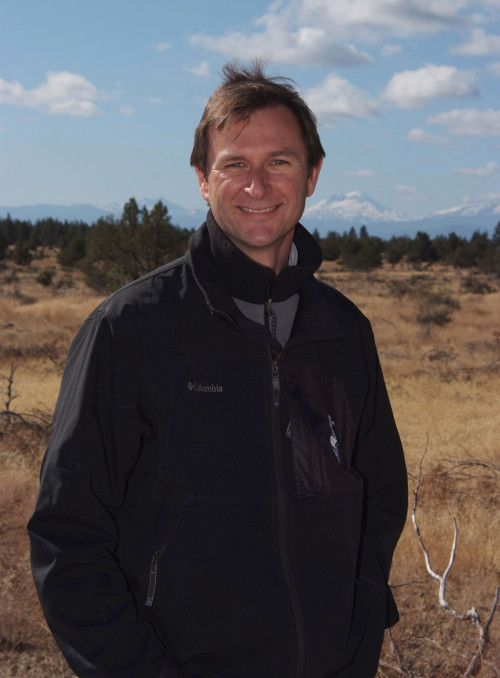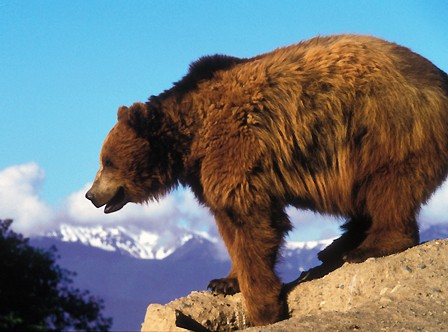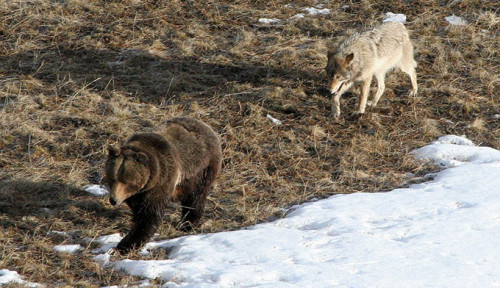Patience and Persistence: An Interview with Grizzly Bear Biologist Bill Gaines

Bill Gaines has been at the forefront of the grizzly bear recovery efforts in the Pacific Northwest for 25 years. I recently had the opportunity to sit down and chat with him about the historical struggles of recovery efforts, the impacts of other carnivores in the North Cascades ecosystem and the role education must play in order to successfully implement recover efforts.
Mike Rosekrans: What initially got you interested in bears?
Bill Gaines: I finished my undergrad and went into my Masters pretty quickly where I studied harlequin ducks, so I really wasn’t a bear person coming out of school. I’d always been interested in bears, but it was something I never had the opportunity to focus on. I then went to work for the Forest Service where I was on a crew that was collecting information about habitat for bears in the North Cascades as part of an effort that started in the mid-80’s and ended in the early-90’s to evaluate whether the Cascades had the capability to support a recovered population of grizzly bears. I was working on the habitat side of that process as a field crew person. The fellow who was leading the habitat evaluation wound up moving after a few years, so in the late 80’s I found myself taking over the role of the leader of the habitat evaluation component. It then became pretty obvious to me that I needed to immerse myself in bear biology and ecology.
I began going to different meetings where I got to meet all these interesting people from all over the world who got to work with bears. I immersed myself in the literature, and had an opportunity to get involved with research on black bears in the Cascades for my PhD dissertation. This really gave me the opportunity to get into the research side and get out in the field and track bears around and start learning about how they behave here in the Cascades.
I got to be very intimate with many of the parts of the Cascades and had black bears radio collared on the eastside and the westside. So it was four years of field research that really became a dream job! That got me hooked on bears and I started to become more and more fascinated with their ecology, their intelligence, and their behavior. After I finished my PhD, I became involved with the development of the recovery planning for the grizzly bear in the Cascades.
MR: How important is it to reach the younger generation, who will ultimately be the future managers, to just go out and to educate the general public?
BG: I can’t underscore the importance of education enough. It’s vital to our future, its vital to the bear’s future. There is a whole host of conservation issues that benefit from a deeper understanding by the general public and especially by the next generation.
In my career, I have worked hard to bring graduate students into research and management so that the next generation of biologists are prepared and ready to take on the challenges. I think we also need to continue to reach out to younger generations such as elementary school-aged kids who are interested in the environment. They have that natural curiosity that is so exciting to get involved with, and you can use that energy, excitement, and curiosity to teach them about a variety of natural resources, but bears in particular. There’s just something about bears that people connect to.
In my career of 30 years of working in conservation, I have found that there is always a need for more and more education. Programs like North Cascades Institute’s Mountain School and similar organizations are absolutely vital and we need more of them. It is so important for how the next generation will deal with really, really challenging issues when you think about conservation and climate change.

MR: Montana seems to do a very good job with bear education. What could we in Washington learn from them?
BG: Yeah, I think Montana does a great job. Part of what is to their advantage is the fact that they have been into grizzly recovery for so long that they’re beyond the idea of recovery and they’re into, “How do we live better with these animals now that we have quite a few?” It’s the reality of having bears that people see frequently, especially when you take a drive through Glacier National Park. They have a reality there with bears that we have with black bears here in Washington, but not with grizzlies, and as a result of that it has advanced their educational efforts, curriculum, and their programs substantially. I think we have that opportunity here in the Cascades to to learn from others who have had that history of living with bears.
MR: How do we best reduce and eliminate fear associated with the grizzly?
BG: It goes back to education and the messaging that we put forth. I like to talk about the “real bear” and the “imaginary bear.” The “imaginary bear” has two extremes; it has the “killer grizzly bear” that they show in the movies that is so far-fetched that there’s no reality and is what feeds into our human fears. Then on the other side is the “teddy bear,” which is your cuddly thing that still has no sense of reality. It is between these two extremes where the “real bear” lives.
I think we owe it to people who are making personal decisions about how they feel about grizzly bears and grizzly bear recovery to give them the facts about the risks that are associated, the behaviors that you can use in bear country to reduce those risks, and to try to give them a true sense of what the realities are.
People need to know things like: how does a grizzly make its living, what are the risks when you go into bear country, and what are those things you do to reduce those risks? That is the education that we really need, the education that we can’t do enough of, but its really important that we categorize the “imaginary bear” from the “real bear” and people start to form their decisions based on conservation and recovery on the perception of “the real bear.”
MR: There are a lot of really good documentaries and films about grizzlies that have come out, but this all goes out to the public who don’t know much about bears and may get the wrong idea when they see film makers dangerously close to these bears. Do you see any problems with bear documentaries and how they play to people’s emotions?
BG: I do. Again, I think that there’s been some situations where those folks making documentaries have gotten themselves into situations where things didn’t go well and it ultimately does more harm to our efforts than you can imagine, even worse than negative newspaper articles. But I do also think that film is a powerful tool. I think that documentaries that tell the story of the “real bear” are a powerful tool that can reach a certain audience. But you’re right, I think we need to go beyond that, and there are other audiences that we still have to reach and I like to think that one way to get to those audiences is to get through to the kids. I think that when you educate kids about the “real bear” they can take that information home, which is a way of reaching parents who may not normally be reached. So it’s a multi-pronged, multi-faceted approach and I do believe you need to be careful about the documentaries and what sort of message your are leaving the public when you do that.
MR: Do you see any problem with romanticizing the grizzly bear as a symbol of wilderness?
BG: I think we have to be cautious about it. I think we hold grizzly bears up as a symbol because we think about areas as having bears as being wild areas and I think there is some truth to that, however when you look at populations of bears in Europe I wouldn’t necessarily call those places “wild.” As with many things, there are generalities and exceptions. I think the ideas of “wilderness” and “wildness” are important, and I think it has importance to us psychologically as a species. I do believe that when you are in bear or wolf country and you are exposed to animals that are at the top of the food chain, it makes you think differently. I find that to be extremely healthy and extremely enlightening. That’s what I associate with “wildness:” that sense of being right in there amongst all the other species as opposed to being the dominant species.

MR: How will other carnivores influence the bear recovery?
BG: There will be some interactions with the carnivores that have historically occurred here but we haven’t seen for a long time. I think our best indicator of that would be the research in Yellowstone. The wolf has really opened our eyes to the role that top-level carnivores play in ecosystems and the interactions between them. Having grizzly bears not den during winter months because they can scavenge on wolf kills blew our minds when we found that happening in Yellowstone.
The number of other carnivores like cougars and both black and grizzly bears and other mesopredators that feed off those wolf kills has just been amazing and, in addition to that, a long list of other species that will scavenge and take advantage of those food resources. These carnivore-to-carnivore interactions are quite fascinating. There have been cases where grizzly bears have preyed on black bears. I don’t think they’re frequent enough in that predators are going to have major implications on each other’s populations, but they’re probably going to change their food habits and how they use their habitats.
Wolves in particular have tremendous influences on other components in an ecosystem because they’re such strict carnivores, much more so than grizzlies, wolverines and other carnivores. In Yellowstone, where they have a lot of wolf habitat in protected areas, they’ve been able to have those populations increase fairly significantly over the last 20 years since they were reintroduced.
What are going to limit wolves in Washington are the human interactions. Because the Cascades are composed so much of higher elevations, the wolves have to interact with people during the wintertime, and it will be interesting to see whether our wolf populations are able to increase at the same level they did in Idaho and Yellowstone because of the people interactions they’re going to experience. It takes a fairly significant population of wolves to exert influences on the other parts of the ecosystem and it’s a question mark in my mind whether we’re going to get there with our wolves in Washington because of the human interactions.
MR: You have been involved with the North Cascades grizzly bear recovery efforts since its inception back in the early 90’s and its been without a doubt a struggle. I’m curious as to what keeps you going?
BG: That’s a good question, and I’ve asked myself that question many times. What keeps me going after so many decades is that, even though progress has been slow for grizzlies, we have done a lot of work to conserve so much of this wild landscape over the course of those couple decades.
I have seen great progress towards other carnivores. When I started 25 years ago the idea of having wolves back on this landscape was a long, far-fetched dream. The idea of wolverines returning is great. I have seen progress because we have kept this large ecosystem in relatively good shape, so it has provided the opportunity for some of these other carnivores to reestablish themselves. While I certainly have my sense of encouragement and discouragement toward the grizzly bear, we have these other carnivore success stories that have provided motivation to keep going. And it’s still uncertain where we will end up with the grizzly bear, but I think we just have to give it our best try and see how society decides to deal with it.
I have a special place in my heart for the grizzly bear. I’ve been immersed in bear ecology and recovery for so long now that I’ve really grown to appreciate them as a species. I think its worthwhile investing time in the process. One thing I’ve learned through these years is that the Endangered Species Act and the process that that sets up when a species is listed is not a quick and dirty process at all. It’s a very long, convoluted, political, social and a little bit of a biological process. I think if you really want to succeed as a person interested in becoming an endangered species biologist, you need to have an incredible amount of patience and persistence.

